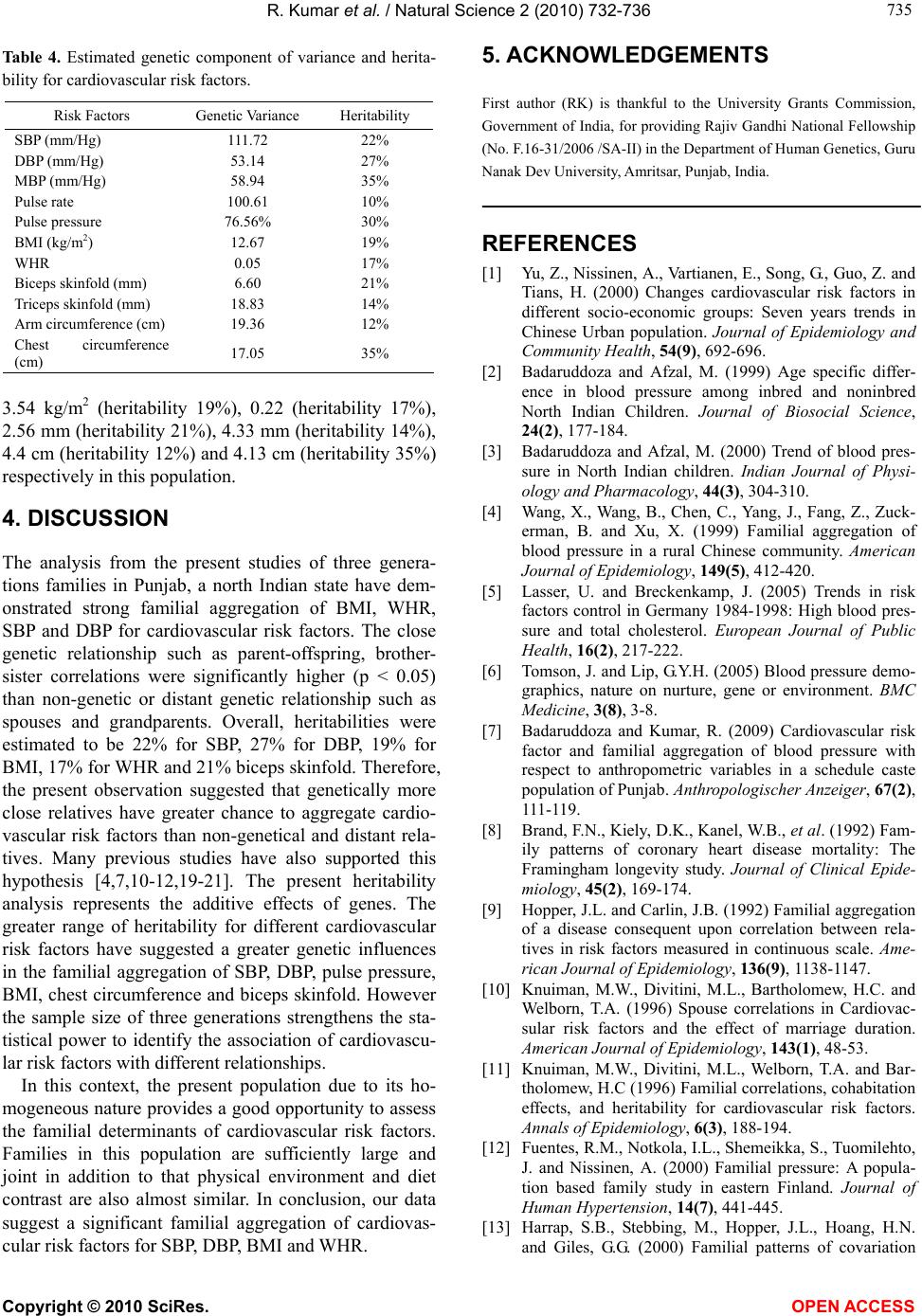
R. Kumar et al. / Natural Science 2 (2010) 732-736
Copyright © 2010 SciRes. OPEN ACCESS
735
735
Table 4. Estimated genetic component of variance and herita-
bility for cardiovascular risk factors.
Risk Factors Genetic Variance Heritability
SBP (mm/Hg) 111.72 22%
DBP (mm/Hg) 53.14 27%
MBP (mm/Hg) 58.94 35%
Pulse rate 100.61 10%
Pulse pressure 76.56% 30%
BMI (kg/m2) 12.67 19%
WHR 0.05 17%
Biceps skinfold (mm) 6.60 21%
Triceps skinfold (mm) 18.83 14%
Arm circumference (cm) 19.36 12%
Chest circumference
(cm) 17.05 35%
3.54 kg/m2 (heritability 19%), 0.22 (heritability 17%),
2.56 mm (heritability 21%), 4.33 mm (heritability 14%),
4.4 cm (heritability 12%) and 4.13 cm (heritability 35%)
respectively in this population.
4. DISCUSSION
The analysis from the present studies of three genera-
tions families in Punjab, a north Indian state have dem-
onstrated strong familial aggregation of BMI, WHR,
SBP and DBP for cardiovascular risk factors. The close
genetic relationship such as parent-offspring, brother-
sister correlations were significantly higher (p < 0.05)
than non-genetic or distant genetic relationship such as
spouses and grandparents. Overall, heritabilities were
estimated to be 22% for SBP, 27% for DBP, 19% for
BMI, 17% for WHR and 21% biceps skinfold. Therefore,
the present observation suggested that genetically more
close relatives have greater chance to aggregate cardio-
vascular risk factors than non-genetical and distant rela-
tives. Many previous studies have also supported this
hypothesis [4,7,10-12,19-21]. The present heritability
analysis represents the additive effects of genes. The
greater range of heritability for different cardiovascular
risk factors have suggested a greater genetic influences
in the familial aggregation of SBP, DBP, pulse pressure,
BMI, chest circumference and biceps skinfold. However
the sample size of three generations strengthens the sta-
tistical power to identify the association of cardiovascu-
lar risk factors with different relationships.
In this context, the present population due to its ho-
mogeneous nature provides a good opportunity to assess
the familial determinants of cardiovascular risk factors.
Families in this population are sufficiently large and
joint in addition to that physical environment and diet
contrast are also almost similar. In conclusion, our data
suggest a significant familial aggregation of cardiovas-
cular risk factors for SBP, DBP, BMI and WHR.
5. ACKNOWLEDGEMENTS
First author (RK) is thankful to the University Grants Commission,
Government of India, for providing Rajiv Gandhi National Fellowship
(No. F.16-31/2006 /SA-II) in the Department of Human Genetics, Guru
Nanak Dev University, Amritsar, Punjab, India.
REFERENCES
[1] Yu, Z., Nissinen, A., Vartianen, E., Song, G., Guo, Z. and
Tians, H. (2000) Changes cardiovascular risk factors in
different socio-economic groups: Seven years trends in
Chinese Urban population. Journal of Epidemiology and
Community Health, 54(9), 692-696.
[2] Badaruddoza and Afzal, M. (1999) Age specific differ-
ence in blood pressure among inbred and noninbred
North Indian Children. Journal of Biosocial Science,
24(2), 177-184.
[3] Badaruddoza and Afzal, M. (2000) Trend of blood pres-
sure in North Indian children. Indian Journal of Physi-
ology and Pharmacology, 44(3), 304-310.
[4] Wang, X., Wang, B., Chen, C., Yang, J., Fang, Z., Zuck-
erman, B. and Xu, X. (1999) Familial aggregation of
blood pressure in a rural Chinese community. American
Journal of Epidemiology, 149(5), 412-420.
[5] Lasser, U. and Breckenkamp, J. (2005) Trends in risk
factors control in Germany 1984-1998: High blood pres-
sure and total cholesterol. European Journal of Public
Health, 16(2), 217-222.
[6] Tomson, J. and Lip, G.Y.H. (2005) Blood pressure demo-
graphics, nature on nurture, gene or environment. BMC
Medicine, 3(8), 3-8.
[7] Badaruddoza and Kumar, R. (2009) Cardiovascular risk
factor and familial aggregation of blood pressure with
respect to anthropometric variables in a schedule caste
population of Punjab. Anthropologischer Anzeiger, 67(2),
111-119.
[8] Brand, F.N., Kiely, D.K., Kanel, W.B., et al. (1992) Fam-
ily patterns of coronary heart disease mortality: The
Framingham longevity study. Journal of Clinical Epide-
miology, 45(2), 169-174.
[9] Hopper, J.L. and Carlin, J.B. (1992) Familial aggregation
of a disease consequent upon correlation between rela-
tives in risk factors measured in continuous scale. Ame-
rican Journal of Epidemiology, 136(9), 1138-1147.
[10] Knuiman, M.W., Divitini, M.L., Bartholomew, H.C. and
Welborn, T.A. (1996) Spouse correlations in Cardiovac-
sular risk factors and the effect of marriage duration.
American Journal of Epidemiology, 143(1), 48-53.
[11] Knuiman, M.W., Divitini, M.L., Welborn, T.A. and Bar-
tholomew, H.C (1996) Familial correlations, cohabitation
effects, and heritability for cardiovascular risk factors.
Annals of Epidemiology, 6(3), 188-194.
[12] Fuentes, R.M., Notkola, I.L., Shemeikka, S., Tuomilehto,
J. and Nissinen, A. (2000) Familial pressure: A popula-
tion based family study in eastern Finland. Journal of
Human Hypertension, 14(7), 441-445.
[13] Harrap, S.B., Stebbing, M., Hopper, J.L., Hoang, H.N.
and Giles, G.G. (2000) Familial patterns of covariation